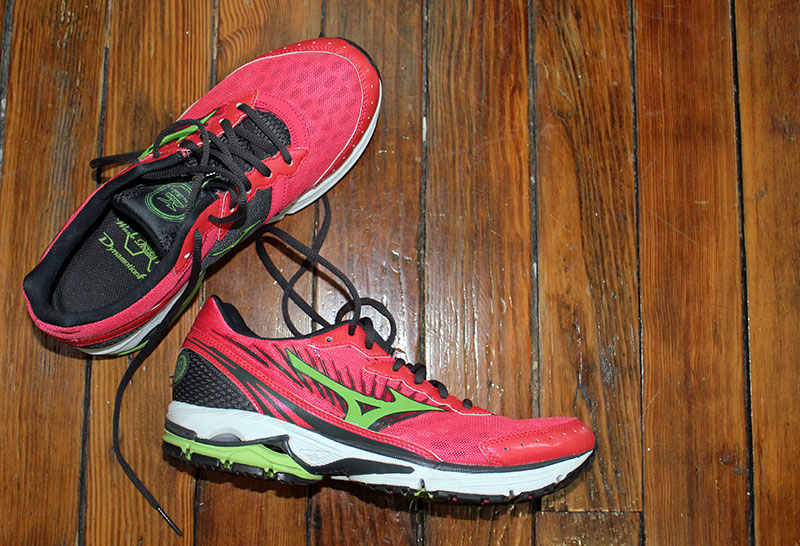Running is often seen as an inexpensive alternative to having an expensive monthly gym membership. However, what many people tend to forget is that running isn’t just about buying a pair of shoes and venturing out into the great outdoors. In actuality, it’s a hobby that can vary greatly in terms of expenses.
Things You’ll Need and How Much They Typically Cost
Shoes: $60 – $150 every 300 – 500 miles
It goes without saying that shoes will cost you money. And shoes can be expensive! If you’re serious about using running as an alternative to the gym, you’ll want to make sure you get shoes that will be able to carry you from point A to point B with minimal injuries and that will fit well. This means purchasing a quality pair and replacing them every 300 – 500 miles that you log. My latest pair of shoes cost me a cool $115 and I typically buy 2-ish pairs per year, depending on how much I’m running. My spending is probably middle-of-the-road, so you may find yourself spending more or less than me.
Running clothes: Varies
If you go to the gym already, it’s likely that you’ll have gym clothes. There can be some overlap between your gym clothes and your running clothes, but you may find yourself buying a wider variety of items to account for the wider variety of weather conditions you’re running in. Cold weather, warm weather, and hot weather gear all varies and when you add in different conditions like snow or rain, you’re looking at even more additional items.
Water bottles and belts: $20 – $50 each
Running long distances and during the hot summer months requires hydration. Water bottles and belts can help you bring your water with you. Yes, there are ways to get around having a water bottle belt, like carrying a bottle in your hand, relying on public water fountains or even hiding water bottles on your route before you depart, but actually having a water bottle belt will ensure that you’re able to stay plenty hydrated. Water bottle belts and belts without water bottle holders
also have the added advantage of giving you a place to bring your cell, ID and fuel with you on your run.
Fuel: Varies
This might be more important for people who run longer distances, but one thing that is often overlooked when thinking about the cost of running is the food that must go into your belly in order to allow you to run at your best. GU gels and other sports fuel items, like Chomps
(my favorite) replenish your electrolytes and give you the energy you need to power through your run. In addition to sports fuel, it’s also likely that you’ll be hungrier in general as you amp up your weekly mileage.
Race fees: $20 – $100 per race
While not a necessity, participating in races can be fun and excellent motivators. While races are fun, they do add up in terms of cost. The race itself generally costs $20 – $100 with shorter runs on the cheaper side and longer runs, like half marathons or marathons on the more expensive side. If you’re doing a run that’s in a different city than you live, add in costs for travel, lodging and food. And, as I mentioned above, the more you’re running and preparing for races, the more food you’re going to be consuming. Beware: runner’s high after a big race is a tricky demon. You may find yourself wanting to immediately sign up for another race!
GPS and other electronics: $0 – $300
A cool thing about running today is that there are a lot of ways that you can automatically collect data around your run, including your route, your pace, your time, and even the elevation. The amount that it will cost you to do that can vary greatly, however. You can use your smartphone (considered $0, if you had one already) or you can buy a special GPS watch for your wrist. This isn’t a necessity for everyone, but if you like to set running-related goals for yourself, they can come in handy.
Injuries: Varies
Hopefully, you’ll never have to deal with a running-induced injury; however, you must be aware that if you do get injured, it can add up. And I’m not just talking broken bones or sprained ankles. Last summer, I took a spill where I scraped up my knee and elbow pretty badly. You wouldn’t think it, but Band-Aids and other first aid supplies are expensive: I spent nearly $40 on Band-Aids in a span of only two weeks! If you have a more serious injury, you’ll be looking at doctors appointments and potentially physical therapy.
Sunscreen and shades: Varies
Venturing into the great outdoors to run typically means that you’re going to be venturing out into the sun. The more you run, the more you’re exposed to the sun. And the more you’re exposed to the sun, the more you’ll want to make sure your skin is protected. You may already have sunscreen, but it’s likely that you’ll run through it faster than before. And you may use your regular sunglasses, but may want to consider getting a pair of sports sunglasses.
Putting It All Together
The great thing about running is that it’s flexible. It’s really up to you how much you want to commit to running, and, ultimately, how much you want to spend on running. If I had to make a gross estimate about the cost of running, I would say that the more miles you run per week and the more races you run per year, the more expensive it will be.
If you’re running a pretty low mileage each week (say, under 20 miles) and you’re doing it just for fun, it’s likely that you’ll be able to get away with the basics: shoes, workout gear, possibly a belt to carry your phone or ID, and sunscreen shades.
However, once you start running longer distances and entering into more races, you’re going to start paying more. Gear for multiple seasons, water belts, fuel, and race admissions really can add up. Throw in an injury and you’re looking at some hefty cash out of your wallet.
As I said, at the end of the day, it’s up to you how much you spend. For some people, this stuff may be complicated and they may prefer just sticking with the standard monthly gym cost. Others might prefer the flexibility that allows them to increase and decrease the amount they spend on running as their budget allows.
No matter what you choose, it’s clear that running isn’t as simple as just investing in a pair of shoes and hitting the ground running. The cost of running can vary greatly… and quickly add up.




